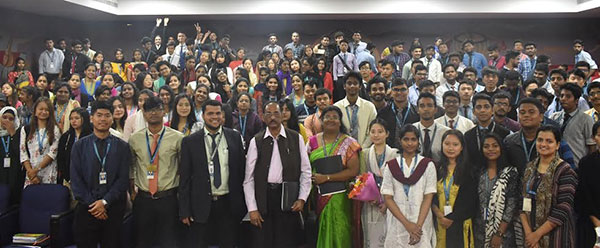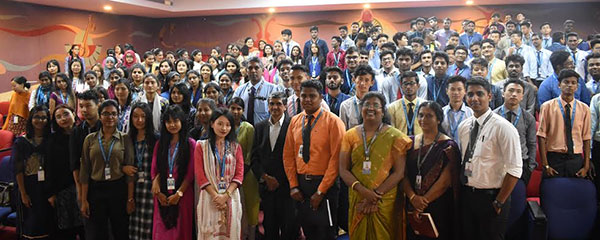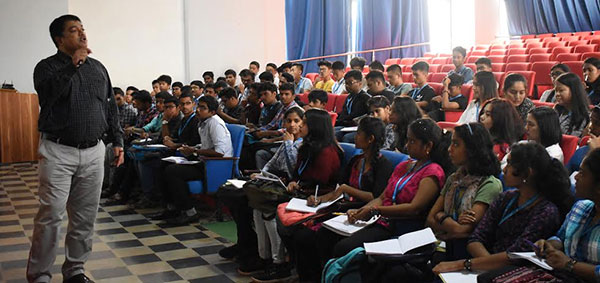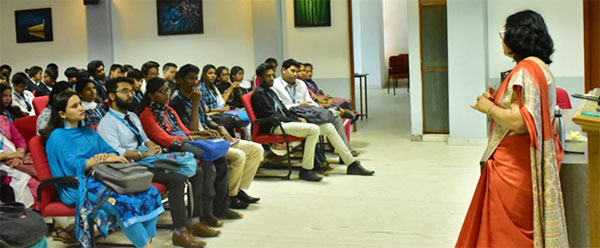
Department Guest Lectures
Role of Museum in 21st Century
The Department of History in collaboration with Sofia Girls College, Ajmer organized an online guest lecture on Role of Museums in 21st Century on 5th December 2020. The session began at 10 AM by invoking the presence of almighty through a silent prayer. After which Prof Ramya B, Head of Department of History welcomed the gathering. Further Ms. Pooja P Patil, student coordinator of History Club introduced the resource person to the gathering and then the platform was handed to Ms. Namrata Sarmah to deliver the lecture. In her lecture, the resource person covered various spheres of museology. She also helped the students know various online methods to visit museums digitally. Ma’am shared her work experience and helped students to understand and appreciate the efforts and work behind setting up of a museum. The speaker through her lecture helped students develop an interest in museology. After the completion of the lecture the platform was opened for discussion and Q & A session. Post this, three student representatives from Sofia Girls College, Ajmer and Kristu Jayanti College (Autonomous), Bangalore shared their experience and intakes on the guest lecture. The session came to an end with the delivering of the vote of thanks by Asst. Prof. Hemango Akshay Hiwale.

Gems of Karnataka Series III: Contributions of Prof Shadakshari Settar
Date: 10/10/20
Time: 10 am onwards
Platform: Zoom
The Department of History instituted a lecture series in the academic year 2019-20 title “Gems of Karnataka” to commemorate and celebrate lives and contribution of imminent personalities who have contributed to the socio-political, economic and cultural arena of Karnataka. On 10th of October 2020, the department organized the third lecture for the series. The resource person for the event was Prof. Dominic D, special officer to Ramanagar, Bangalore University PG Centre and Kannada Study Centre of Bangalore University. The session began at 10 am by invoking the presence of the almighty through a silent prayer. The welcome address was delivered by Prof. Ramya B, Head of Department of History. Ms. Pooja P Patil, student of V BA HEP and student coordinator of History Club introduced the resource person to the gathering. Time was then given to the resource person to deliver the lecture. In his lecture the resource person effectively spoke about the life and contributions of Prof. Shadakshari Settar. He spoke on the various thesis put up by Prof. Shadakshari Settar and explained how Kannada is not an outcome of Sanskrit rather it was a language that existed along with Sanskrit. He also explained the antiquity of Kannada language by giving examples of various edicts and manuscripts.
Throughout the lecture one could easily understand how indeed Prof. Shadakshari Settar was a gem of Karnataka. After the completion of the lecture, the platform was open for discussion and a Q & A session. The session came to an end with the Vote of Thanks delivered by Asst. Prof. Hemango Akshay Hiwale.

Preparation for Civil Services Examination- Staying Motivated and Focused
The Department of History organized a Guest Lecture titled “Preparation for Civil Services Examination- Staying Motivated and Focused” on the 13, August 2020 through the online platform for the 3rd year History students in tandem with their VAC classes on the subject matter “History for Competitive Examinations.”
The lecture began with a welcome address and introductory speech by Prof. Ramya B. After which the platform was given to Ms. Maiza Mohammed. She addressed the students by giving various tips to crack UPSC and to stay motivated. Madam discussed about the SWOC analysis strategy [Strengths, Weaknesses, Opportunities and Challenges]. She also emphasized on various aspects like: Time management, daily news reading, Précis writing, etc. After the address by the resource person the session was opened for interaction with the aim for students to clear their doubts. The session ended with the vote of thanks by Prof. Ramya. B. There were 53 participants. Students felt the workshop was very helpful to make their own strategies while preparing for competitive exam and are looking forward for more such fruitful sessions.

"Gems of Karnataka Series II: Dewan K Seshadri Iyer"
“The Department of History organized the second edition of ‘Gems of Karnataka Series II: Dewan K Seshadri Iyer’ to commemorate the contributions of various figures in Karnataka. Prof Dr. B Narasingaraja Naidu, spoke about Dewan K Seshadri Iyer and his contributions to the development of Karnataka. He shared with the students how Seshadri Iyer joined the services of the Mysore kingdom in 1868 and served as a district magistrate and later as Personal Secretary to the Diwan, Rungacharlu before being appointed Diwan himself. He also focused on the fact that Seshadri Iyer was the longest serving Diwan of Mysore kingdom and served from 1883 to 1901.
He also highlighted his contributions which came in the form of establishing the Kolar gold fields and the Victoria Hospital in Bangalore. The speaker also pointed to how Diwan Iyer was responsible for the commissioning of the Shivanasamudra hydel-electric power project. Seshadri Iyer had to deal with a devastating plague which afflicted Bangalore in 1898 and was responsible for the decongestion of streets and reconstructing the city in the aftermath of the plague, tagging his as one of the many ‘Makers of Modern Bangalore’. He also spoke about the contributions of the missionaries to the education sector in India as well as helping the recovering of the Bangalore city during the plague.”

Gems Of Karnataka – Makers Of Modern Karnataka
Interactive lecture series celebrating the “Gems Of Karnataka – Makers Of Modern Karnataka” was organised by the Department of History, Kristu Jayanti College on July 22nd 2019. The narrative of achievements of Maharaja Krishnaraja Wodeyar IV and Bharat Ratna Shri Visveshwarya the true visionary leaders who established the best governed state of the world in the 20th century at Mysore silenced the voices of colonial supporters who believed that modernisation of India truly begun and probably succeeded due to British rule. The series commenced with the blessings of Rev Fr Josekutty P.D, Principal, Kristu Jayanti College and the address was delivered by Dr. Vithal Potdar from Mythic Society, Bengaluru in an enchanting manner to spellbound audience of History students and faculty members of various departments. Mahatma Gandhi called the Maharaja Krishnaraja Wodeyar IV as ‘Rajarshi’ and his kingdom as ‘Rama Rajya’ is truly considered as the ‘Golden Age’ of Modern Mysore. Bengaluru becoming the first city with electric street lamps, establishment of Indian Institute of Science with the donation of 371 acres of land, creation of legislative council in 1907 voluntarily to promote democratic governance, introduction of compulsory primary education through1913 Regulation and favourable social legislations for the upliftment of women and backward classes are just few indicators of the sustainable progress and holistic growth made by Mysore during their period. The speaker quoted from ‘The Great Britain and the East’ paper published from London in March 1939 edition had addressed the Mysore State as ‘Buckingham of India’ due to its overall progress in many spheres.
Bharat Ratna Shri Visveshwarya guidance on how to face the raising challenges remains true and stand the test of time , ‘Education is the sovereign remedy for all economic ills’…’The way to build a better nation is to build better individuals’… ‘Education shall be so diffused that there may not be a village with an ignorant family nor a family with an ignorant member’. The programme was organised by Prof Ramya.B, Head, Department of History and Prof. Hemango Akshay Hiwali, faculty, Department of History.

Numismatics as a Source of History
Date: July 4, 2019
Classes Attended & Number of beneficiaries: I BA HEP & HTJ. 77 nos
Name and details of the Resource Person: Mr. Gautam Jantakal, Numismatics Consultant,
Centre for Numismatics Studies, Bengaluru
Objective:
1. To enhance student’s understanding of Numismatics as an integral source of History
2. To cultivate interest and appreciation in the study, collection and preservation of coins.
The Department of History organized a guest lecture on Numismatics as a source of History to First year UG students to develop curiosity and understanding of learning history through authentic archaeological sources. Mr. Gautam Jantakal, an expert numismatist provided an opportunity for student to see, touch and learn about old coinage practices that existed in India and gave a wonderful outline about the significance of coins to understand the glorious past of India. He elaborated to them the various degrees of information, a numismatist can extract from a coin about the past and how it helps historians in reconstructing a particular period. A strong motive was also to introduce students to an emerging and unique career path of being a numismatist and to arouse in all a passion for the field of studies. Students actively involved in the session by asking multiple questions and getting clarification on their doubts regarding numismatics.

Unique Aspects of Indian Art
Date: 21/01/19 | Time: 01:30- 03.30 pm
Number of beneficiaries: 95 students and 3 faculty members
Resource Person: Dr. Jaya Jose, Art Historian & Research Fellow, National Institute of Advanced Studies, IISc Campus, Bengaluru
Objectives:
1. To create awareness on Ancient Indian Art
2. To appreciate the significance of Art Indian History
3. To encourage the budding artist in the college
The guest lecture started with a formal welcome speech by Ms Sandhya, a second semester student of HTJ. Over a span of two hours, the resource person covered the various aspects of Ancient Indian Art forms. The lecture narrated the uniqueness and the salient features of Early Indian art forms.
Dr. Jaya also pointed out the rediscovering of the exquisiteness of this art form during the colonial regime in India which helped in the process of fostering nationalism among the people. Focusing on the multicultural essence of Indian art form, Dr Jose argued how numerous foreign inspirations, such as that of the Greeks and Romans, have influenced and inspired the indigenous art form. She also viewed and portrayed the Indian art form as an evolving and not stagnant entity.
Students of second semester HEP and HTJ and fourth semester CBCS students of Indian Cultural Heritage from various courses, such as B.Com, B.Com Prof, B.Com ACCA, BBA, B.Com Tourism and B.Sc Biotechnology attended the lecture. The lecture ended with Assistant Professor Hemango Akshay Hiwale offering the vote of thanks.

Role of Numismatics in History
Date: 20/07/18
Classes Attended & Number of beneficiaries: I BA HEP and HTJ, 63 nos.
Name and details of the Resource Person: Mr. Gautham Jantakal, Numismatic Consultant Centre for Numismatic Studies, Bengaluru
Objective: To highlight the role of the coinage as an important agent of reconstructing History
One of the most important part of the Numismatics Exhibition held on the 20th July 2018 and which also became the essence of the day, was an extension lecture organized specifically for the first year HEP and HTJ students . The lecture session was on the topic, “Role of Numismatics in History”. The speaker for this session was Mr. Gautham Jantakal. He is a postgraduate from the University of Mumbai and holds an M.A in Numismatics and Archaeology. He is also an esteemed member of organizations such as Karnataka Numismatic Society, South India Numismatic Society and Oriental Numismatic Society.
The session started with an introductory remarks by Mr. Hemango Akshay Hiwale, the class animator for the HEP and HTJ semester I. Nidhil C. Prakash Nair, a student of HEP Sem I introduced the guest. The lecture which revolved around coins and understanding them as an important historical source, incorporated various examples from the past reverberating its significance to the nuanced study of Indian History. Various information that one can attain from such coins and the manner in which it helps to reconstruct one’s past was highlighted The students were provided with few rare coins to learn and understand the usage of coins. Akash Shree, another first year student delivered the Vote of Thanks, which brought the session to a closure.

EXPERT LECTURE on “Heritage Conservation Management- Role of Youth”
Date: 9/10/2018 | Time: 11.00-1.30
No of Beneficiaries: B.A: 192 students; B.Com Tourism: 313 students
The Department of Tourism and History collaborated and organized Expert Lecture on “Heritage Conservation Management- Role of Youth”. Shri. Muhammed K. K., esteemed Former Regional Director of Archaeological Survey of India, popularly referred as ‘Man of Monuments’ mesmerized the audience about the need and importance of conserving the heritage sites along with eloquent passages from Upanishads, Poet Md. Iqbal’s writing and his field experiences.
The Bateshwar Hindu temples are a group of nearly 200 sandstone Hindu temples in north Madhya Pradesh built in post-Gupta, early Gurjar-Pratihara style of North Indian temple architecture. His dedicated work of conserving the heritage sites of India by reclaiming ruined rubbles to beautiful monuments in eight years left an indelible impression. Shri. Muhammed spoke on the challenges faced by archaeologists in the field including interference of dacoits at the Chambal Valley. His case studies showcased examples of positive engagement of local people, students, youth and others including dacoits resulting in the conservation of cultural heritage monuments.
He quoted "Tough situations never last but tough people always will” and encouraged the students to work for the society with various small acts of kindness. He was given the Citizen Journalist award one among the many other awards he had received for providing education to poor adults and children through an initiative called as ‘education at the monument’.
The session was presided by Rev. Fr. Augustine George, Vice Principal, Dr. Gopakumar, Dean of Humanities, Prof. Vijayakumar R, Head, Department of Commerce, Prof. Retheesh P.T, Faculty of Tourism and Prof. Ramya, Faculty of History.
The session motivated everyone to work towards achieving the upanisadic goal of ‘Asatoma Ma Sadgamaya’

Research Themes in Bangalore History
Date: June 29th 2016 | Time: 11.00 -1.00 P.M
Classes Attended: I, III, V Sem B.A HEP/ HTJ students Number of beneficiaries: 117
Resource Person: Dr. Meera Krishnappa Principal, Dr. NSAM first Grade College Yelahanka, Bengaluru
Objective: To instill an understanding of Bangalore and motivate to pursue historical research
Prof. Meera Krishnappa, made an enlightening presentation on the background and history of Bangalore. The session was highly interactive. Quiz on Personalities, famous historical and cultural places at Bangalore with interesting anecdotes kindled the interest of all. A brain -storming session on the possible research topics in Bangalore yielded several interesting ideas such as the study of street names, transport sector, Silicon valley, monuments, lakes, sports and film personalities. The session revealed the zeal of young researchers and their enthusiasm to undertake challenges.

'Neolithic age Migration from the Indus Valley to Coastal Europe"
Date: February 11th 2016
Classes Attended: II, IV, VI Sem B.A HEP/ HTJ students Number of beneficiaries: 110
Resource Person: Prof. William Borsboom, Canadian expert in Philology and archeology
Prof. William Borsboom, made an enlightening presentation and discussion on the latest research findings of late Harappan Phase. Based on language, archaeo-genetic and archaeological data, his theory proposes that over an extended period of time between 9,500 and 3,350 BPE large segments of the river-faring, sea-faring population of the north-western delta of the Indian subcontinent - the Indus Valley or the Sapta Sindhu region left their homeland to look for other shores because of
• a natural human inclination to “look for other shores” and
• driven by a number of natural catastrophes and diseases (such as leprosy, tuberculosis **) that resulted from them.
According to Prof. William these multiple group migrations went into three main directions.
1. Migrations overseas to coastal European lands - from Red Sea, Mediterranean and as far as Baltic Sea coastal regions ***,
. Migrations within India to North, North East, Central and Southern Indian regions where they, over time, merged with the existing populations and cultures ***.
3. Further East overseas, via Sri Lanka, even as far as the Pacific Ocean's archipelagos and the Americas.
It was an interesting and enlightening talk on the antiquity of Indian civilisation and Sanskrit could be basis of several languages of Europe. In addition to all of this, Prof. William ‘s passion and primary interest in understanding the history of ancient Indian Epigraphy, Seal and Script interpretation of Indus Valley civilization was an inspiration to the students of the Department of History.


